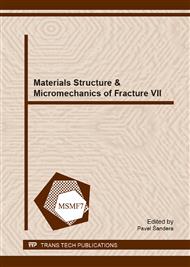p.217
p.221
p.225
p.229
p.233
p.239
p.246
p.250
p.254
Contribution to the Life Prediction of Aluminium Alloys Parts under Isothermal Fatigue
Abstract:
Lifetime prediction, Isothermal fatigue, damage, cracking, aluminium alloys. Abstract. In this work, a tool for lifetime prediction of aluminium alloys parts employed under isothermal fatigue was developed. This tool is a computer code implemented in a "Visual-Fortran" environment and based on a coupled model of the elastoplastic damage accumulation presented by "Lemaitre and Chaboche" [. This model allows us to describe the damage evolution depending on the number of cycles until failure of the representative volume element (RVE). This failure results in the creation of a macro-crack, its propagation over loading cycles to reach a critical size which will cause the part breakdown. The crack growth phase cannot be neglected because it may contain a considerable number of cycles, this is why we have included in the developed model, this phase of crack growth after the initiation phase; it contains mainly the numerical integration of the "Paris" law.
Info:
Periodical:
Pages:
233-236
Citation:
Online since:
November 2013
Price:
Сopyright:
© 2014 Trans Tech Publications Ltd. All Rights Reserved
Share:
Citation:


